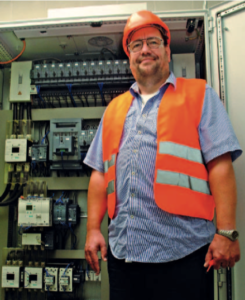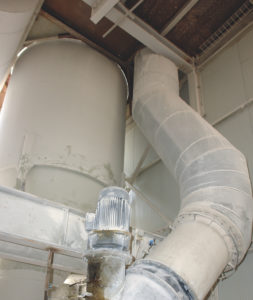Machines and plant become more pro table when they are highly available. This is
also true in gypsum product manufacturing and is the reason why key components at the Saint-Gobain Formula production plant in Walkenried/Südharz are gradually undergoing a retrofit. As part of this project, the electrical systems at the first unit have been completely modernized. All aspects of the engineering process were focused on achieving system integration and investment protection.
Introduction
 “Because our customers expect us to supply very high quality gypsum products, we use only natural gypsum in our process”, explained Olaf Roth, Programming Team Leader at Saint-Gobain Formula GmbH in Walkenried in Lower Saxony near Nordhausen. With a history going back more than 125 years, the company has specialized in the production of gypsum products for customers all over the world. The range of applications for the company’s gypsum encompasses various industries and sectors including, for example, medical / dental, construction, ceramics, art, decor, food, environment and even special engineering applications.
“Because our customers expect us to supply very high quality gypsum products, we use only natural gypsum in our process”, explained Olaf Roth, Programming Team Leader at Saint-Gobain Formula GmbH in Walkenried in Lower Saxony near Nordhausen. With a history going back more than 125 years, the company has specialized in the production of gypsum products for customers all over the world. The range of applications for the company’s gypsum encompasses various industries and sectors including, for example, medical / dental, construction, ceramics, art, decor, food, environment and even special engineering applications.
The company operates various production units to process either alpha or beta-type gypsum plasters. These machines are gradually being upgraded to state-of-the-art technology – including, for example, the MPS roller mill built in 1989 for beta gypsum which grinds crushed gypsum rock into fine particles. Apart from production capacity, plant availability is a key ingredient for successful operation. For this reason, a series of upgrades has been undertaken in order to safeguard future availability.
“In order to meet this goal, we have decided to completely upgrade the electrical systems at the MPS roller mill”, explained Mr. Roth. As a man with plenty of practical experience, he attached particular importance to the following aspects: system integration, future-proofing, simple handling and – last but not least – profitability. When selecting the operator control and monitoring equipment, the control system and the industrial controls, he therefore chose very carefully.
Compact starters with IO-Link communication
To give an example, medium-sized motors with ratings up to 32 A in the gypsum plant are operated by more than a dozen Sirius 3RA6 compact starters. In order to exploit the potential of these devices at the process management level, he also decided to go for an IO-Link-based communication system. This system – specially developed for fast, intelligent communication between sensors and switching devices – ensures seamless communication down to the last meter, so to speak. Simple wiring, fast and comprehensive fault diagnostics and efficient engineering are the basic arguments which convinced him that it was the best choice.
Diagnostic information from the field up to process management level
 The wiring outlay alone can contribute to significant savings because a single IO-Link master with four channels can control up to four compact starters in each channel – a total of 16 starters. In other words, the first of a group of four 3RA64 or 3RA65 compact starters is wired, while the remaining starters are interconnected via a through-connection on the front panel. “The connections are made quickly; the control cabinet wiring is very clearly organized”, said Roth.
The wiring outlay alone can contribute to significant savings because a single IO-Link master with four channels can control up to four compact starters in each channel – a total of 16 starters. In other words, the first of a group of four 3RA64 or 3RA65 compact starters is wired, while the remaining starters are interconnected via a through-connection on the front panel. “The connections are made quickly; the control cabinet wiring is very clearly organized”, said Roth.
A decisive criterion that made this communication system the most appealing choice are its excellent control capabilities. Instead of using a vast number of rotary switches on the control cabinet to switch plant sections, this can now be done centrally. Furthermore, the IO-Link master receives important diagnostic information from the starters including, for example, switching state, short-circuit or overload trip, and imminent end-of-service life signal for main contacts. As Mr. Roth remarked: “The diagnostic information supplied by this system is more detailed than the data provided by a purely binary control. It is of immeasurable benefit to us that we can view this information in the control cabinet during routine checks, but also that it is displayed instantaneously on the operator panel of the unit.” This means that even remote diagnostics down to sensor-actuator level are possible.
Distributed I/Os with IO-Link master
 Three IO-Link masters are installed in the plant as supplementary modules to the distributed Simatic ET 200SP I/O stations. The three masters connect directly to the IM155-6PN HF interface module of the distributed I/Os. This module uses PROFINET to communicate with the plant control system, a Siemens Simatic S7-1500 F. Moreover, the energy meter modules installed in the ET 200SP stations can record electrical data (current and voltage) in the plant. For Olaf Roth, this design structure is simple, well organized, and extremely practical. The same applies to parameterization and diagnostics. The plant electricians can, therefore, operate the switchgear directly via the IO-Link level using the S7 PCT software (Port Configuration Tool) supplied by Siemens without needing to intervene in the control environment.
Three IO-Link masters are installed in the plant as supplementary modules to the distributed Simatic ET 200SP I/O stations. The three masters connect directly to the IM155-6PN HF interface module of the distributed I/Os. This module uses PROFINET to communicate with the plant control system, a Siemens Simatic S7-1500 F. Moreover, the energy meter modules installed in the ET 200SP stations can record electrical data (current and voltage) in the plant. For Olaf Roth, this design structure is simple, well organized, and extremely practical. The same applies to parameterization and diagnostics. The plant electricians can, therefore, operate the switchgear directly via the IO-Link level using the S7 PCT software (Port Configuration Tool) supplied by Siemens without needing to intervene in the control environment.
This software for parameterizing Siemens IO-Link master modules and IO-Link devices is integrated in Step7, V5.4 SP5 and higher, but is also available as a stand-alone version for separate installation. The plant electricians can also carry out service work by using the hand-held unit to connect to the network via PROFINET. A further important detail: the Generic Station Description (GSD) file of certified devices supplied by third-party manufacturers can be used to integrate them quickly into the system.
Safety engineering with all the finer points
The project to retrofit the MPS roller mill in Kützhütte was based on standard automation and safety engineering on the same control hardware. Five distributed I/O stations in mixed operation (modules for standard automation and safety-related signals) are distributed throughout the plant and connected to the plant control system via PROFINET and the PROFIsafe protocol. These units are 50 percent more compact than older versions due partly to the fact that they are equipped with double the number of inputs and outputs. The new versions do not require a separate Power Module or a high-feature head for safety engineering. Even the network connection method is special by comparison with standard versions: instead of over-molded connectors, adapters are used to screw-fasten RJ45, fiber optic, and field-installable connectors. Roth is delighted: “For harsh operating environments with, for example, a lot of airborne dust that can be deposited on contacts, this screw-fastened Fast-Connect solution is just perfect.”
Standard and fail-safe sensors are connected by means of push-in terminals, making the whole connection process just as quick and easy. A large number of sensors for safety engineering applications are comparatively easy to connect so that the useful control functionality they offer can be fully exploited. Let’s take Emergency Stop as an example: in conventionally engineered systems, Normally Closed (NC) contacts are connected in series. When an Emergency Stop button is pressed, the safety sequence is activated and the unit is shut down via the safety relay. A lot of time can be lost in trying to localize the fault on the four-story high unit. The setup in Kutzhütte is quite different: the NC contacts of Emergency Stop buttons are individually routed to fail-safe inputs in the ET 200SP. The control system is immediately notified via PROFIsafe what action needs to be taken. It shuts down the relevant drives via the safe outputs and displays the relevant information for the user. “Troubleshooting is always so time-consuming, but it can be done in no time at all with this system so that plant outages are reduced to a minimum.”
Coded RFID switches for the valves at the rotary table of the mill are another example of how safety engineering has been simplified. The clocked, intrinsically safe OSSD outputs are read into fail-safe inputs in the distributed I/Os. In this instance as well, the control system receives all the status information it requires to keep the valves closed or open for maintenance purposes. Two large Siemens Sirius 3RT incoming supply contactors that are used to deactivate all compact starters via fail-safe outputs in the event of a fault can be integrated easily into the safety concept via PROFIsafe and the distributed I/Os.
System integration as a means of ensuring high availability
The retrofit project for the beta gypsum MPS roller mill at Saint-Gobain Formula illustrates the advantages to be gained from integrated system solutions. From the control system down to field level, this integrated concept not only simplifies the engineering process to a significant degree, but also makes programming and operation much more convenient. Even the mixed operation of standard automation and safety engineering modules becomes easy. A combination of PROFINET and IO-Link creates a communication platform which ensures smooth operation of the plant. In addition, everyone involved in plant operation benefits from the integrated system because anything that happens at the field level is immediately displayed at the process management level.
